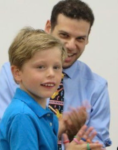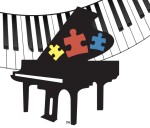Occupational Octaves: Teaching With Heart
 Hi everyone- It’s Lee Stockner with a new post for you! In previous blogs I’ve broken down the how’s and why’s of the Special-Needs-User-Friendly language and the technical steps of the Piano Circle of Cognitive Gain however, no endeavors function optimally in the world of Special Education without a teacher’s approach that is based in observation and empathy.
Hi everyone- It’s Lee Stockner with a new post for you! In previous blogs I’ve broken down the how’s and why’s of the Special-Needs-User-Friendly language and the technical steps of the Piano Circle of Cognitive Gain however, no endeavors function optimally in the world of Special Education without a teacher’s approach that is based in observation and empathy.
For me personally, when I make a decision about how to handle a situation with a special learner, I want it to come from my heart and I don’t believe I can accomplish that without watching and learning about my student and then trying to figure out what I would want if I was in their shoes. This is quite a challenge and for every person, this means something different.
For me, a choice from the heart begins by seeking the common ground of something meaningful for each student (a song, a TV show, a conversation, a preferred reward, etc.), which can be a challenge in and of itself! I can’t count the number of times I’d meet a new student, the parent would tell me something like “Bobby likes _______ and is very motivated to earn it,” but then I learn that the child is really not so motivated by it. I had to question whether or not ‘Bobby’ was simply going through a process or was actually excited in his heart about earning something. What’s next after determining that he’s not motivated for anything?
I know my next step is not just to find something that motivates him/her, it’s to find something that connects with his/her heart. That sounds pretty tough, right?! How do you know how what a child on the Autism spectrum is going to connect with as a motivator?
Well, here’s the good news; one of my students who wasn’t motivated by anything put in front of him loved knowing the tag letters of radio stations around the country! So he would play a few pages and earn getting to go on the internet to look up a rock or talk radio station in Arkansas or Hawaii and it to his note book of items that are connected to his heart. Even though this may be a strange motivator to most, it is simply how to connect with the heart of this particular young man.
I believe that flexibility as a teacher and a willingness to treat students completely differently is a leadership skill with deep benefits. The Hall of Fame College Basketball coach John Wooden was once asked why he treats his twelve players on each team differently. He replied “because they’re twelve different people.” Mr. Wooden’s ability to learn each individual as a person before as a player in addition to handling all the technical steps of his goals with precision and perfection are what made him who he is. Perhaps you are not a John Wooden fan however, his point is very, very significant in the world of Special Needs Music Education. Just like with a traditionally learning group of students, some Special Needs students will love to play and be motivated to do so on their own, while others are filling a responsibility laid out by a parent and are simply working toward a reward unrelated to music (of course with the hopes of fostering a future love for playing).
The tears of one student mean something different than the tears of another and the laughs of one may mean something totally different than the laughs of another.
A negative reaction from one student may happen because he/she doesn’t have the ability to speak and had a horrible day at school that can’t be talked out or described. That student may just not be in the mood to take more instructions and be taught more on the day that I show up for a piano lesson. Judgement calls must be made in these cases; do I push through and try to have him/her play because of the potentially huge therapeutic effect? Do I turn back to earlier songs and/or let the student choose anything to play so he/she can still have a positive experience at the piano? Do I play for the student so that (s)he may possibly just enjoy music for a few minutes without the burden of using a brain that may be exhausted and/or lacking in confidence?
In another student, a similar negative reaction may be occurring because (s)he is immature and uses the behavior in other environments to successfully avoid tasks and responsibilities. A whole different set of questions and courses of action would be used in this second situation. An approach where a teacher tries to put him/herself in the shoes of a student has thus far been a bedrock of my pathway to make empathetic and compassionate decisions rooting from my heart.
Maximizing the potential learning, enjoyment, development and experience at the piano for these types of students and every other variety of learner out there may require you as a teacher to slow down and understand who the person is that you’d like to help toward musicianship, before even acknowledging them as a student and that their learning is your responsibility. In the more than 20 years I spent taking lessons with my teacher, there were plenty of days where something happening in my life was simply more important than what was going on at the piano and we dealt with that issue instead of the musical assignments. The trust developed between us made me not only work harder when with her, it may me feel as though my personhood was significantly more important than my learning. Nothing bred a better environment for learning than that and it later reared itself as the perfect lesson to take with me into the world of Special Needs Music Education!
I write about this particular topic after having a wonderful experience in June. I hosted a Special Needs Piano recital in which 12 of the 13 students are completely unable to read, comprehend, or use traditional piano notation. A major reason why these students play so well is because of the Special-Needs-User-Friendly language featured in Occupational Octaves Piano, but another tremendous reason is because I treat each student using what I consider the approach optimal for that particular individual. I received many compliments from the families about my flexibility with each personality and each situation.
As you watch, you’ll see for yourself just how different each individual student is. While I was very proud of how well the students played, the compliments from parents on how their child and the other children were treated meant the most to me. I believe it was an afternoon that would have made John Wooden proud and another reason why I urge you to treat all of your students differently! Here is the performance list from the day and a video so you can see for yourself. Special Needs Recital Video
1) 0:00 – Mike W. – Wheels on the Bus – Occupational Octaves Piano Book 1
2) 3:13 – Jason W. – Lullaby (Brahms) – Occupational Octaves Piano Book 2
3) 7:23 – Ryan H. – Minuet in G (Bach) – Occupational Octaves Piano Book 2
4) 10:41 – Lincoln S. – This Old Man – Occupational Octaves Piano Book 2
5) 14:43 – Brendan – Air (Mozart) Occupational Octaves Piano Book 3
6) 19:17 – Mike S. – Camptown Races – Occupational Octaves Piano Book 4
7) 22:12 – Annie D. – Alouette – Occupational Octaves Piano Book 3
8) 26:42 – Andrew K. – Theme from New World Symphony (John Thompson’s Easiest Piano Course) duet with Lee & Solfeggietto (Bach) – Occupational Octaves Piano Book 6
9) 32:47 – Ruby L. – Sonatina in C Major- Pt. 1 (Clementi) – Occupational Octaves Piano Book 6
10) 40:32 – Alie S. – Pathetique Sonata (Beethoven) – Occupational Octaves Piano Book 7
11) 47:00 – Jamie S. – Moonlight Sonata (Beethoven) – Occupational Octaves Piano Book 8 Supplement
12) 52:18 – Tribute to Dr. Elise Sobol (Author of An Attitude and Approach to Teaching Music to Special Learners
13) 55:00 – Jake V. – The Blue Danube (Strauss II) – Occupational Octaves Piano Book 8!

